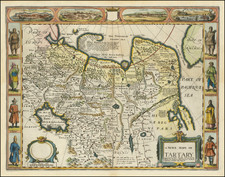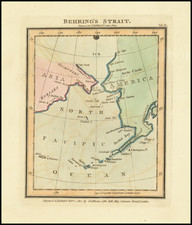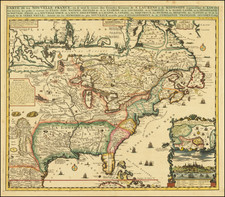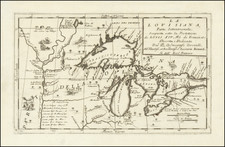Original manuscript proof of Tappan Adney's map of the Klondike and Indian River Gold Regions, drawn during his visit to the Yukon in 1897-98.
The present map is an exceptionally detailed cartographic record of the mining operations, trails, outposts and settlements in the Klondike region of the Yukon, as they appeared during the summer of 1898, as reported by Tappan Adney, perhaps the single important chronicler of the Klondike Gold Rush. The level of detail is so great that Adney's statement that the map is based "on personal surveys and information supplied by miners" clearly holds true.
This manuscript proof formed the basis of the printed map contained in Adney's important account of the gold rush, The Klondike Stampede abou the Klondike Gold Rush, published by Harper & Bros. in New York in 1900. The present map is significantly larger than the map that appeared in the book, which was approximately 8 x 10 inches.
The map embraces virtually all of the productive area of the Klondike Gold Rush, which was largely confined to the Klondike and Indian Rivers and the Bonanza and Hunker Creeks and their tributaries. These rivers met the mighty Yukon River just above Dawson City, the brand new boomtown that was the only settlement of any kind in this rugged subarctic region.
Adney's map presents one of the most detailed and authentic records of the extensive mining operations that had sprung up in barely two seasons. It names every single creek and tributary, and topographical relief is expressed with hachures. Intermittent crossed lines mark the trails used by the miners to access their claims, while the various numbers located at the terminus of each tributary identifies each individual mining claim. 'Discovery Claims,' or those points where gold was first discovered in the early days of the rush, are noted by crossed circles. Other details, such as the locations of 'Road Houses' and mileage markers along the rivers noting the distance from the Yukon River only add to the map's sense of authenticity.
The map is a finely drafted proof, based on rough field sketches, and prepared specifically for the publication of Adney's book. While it is not certain that the map was drafted by Adney personally, it is known that Adney had previously drawn maps to illustrate is "First Trip To New Brunswick . . . " a manuscript Journal kept by Adney as an 18 year old exploring his native New Brunswick. As Adney was an accomplished artist, clearly had the ability to produce such a refined work.
Indicative of the nature of the proof-making process at the time, several creeks previously extending toward the upper-right corner of the map have been erased in favor of including the inset detailing Dawson City. In the same vein, the title 'Klondike and Indian River Gold Fields' has been printed on a separate piece of paper and pasted onto the map, presumably correcting an earlier version of the title. The map also includes the tell tale blue pencil marks added by the editor to note the areas where corrections should be made in the next draft.
The Klondike Gold Rush (1896-99) was one of the most sensational events of the fin de siècle period. Gold was first discovered in the Klondike in what was then Canada's Northwest Territory on August 16, 1896. News quickly spread across North America from what was about the most remote corner of the continent. Newspapers exaggerated the potential of the bonanza in an effort to sell copies, and a mass sensation was born.
Over 100,000 people headed towards the Yukon, however, the region proved so inaccessible only 30,000 prospectors and 'entrepreneurs' actually arrived in the area near Dawson City. Nevertheless, as shown on the map, for three years this migration utterly transformed the area that was caught up in an atmosphere of frenetic ambition and frontier lawlessness. While the Yukon proved be nothing like the El Dorado promised by the newspapers, the 'Klondike' has since occupied a cherished place in North American lore.
Edwin Tappan Adney (1868-1950) was an artist, a writer, a photographer and the man credited with saving the art of birchbark canoe construction. He built more than 100 models of different types, which are now housed at the Mariners' Museum in Newport News, Virginia.
Adney was one of the first photojournalists to pass safely through British Columbia. As a freelance correspondent for Harper's Weekly, he was sent with his camera to the Yukon from 1897 to 1898. His classic illustrated book The Klondike Stampede about the Klondike Gold Rush chronicles his experiences in the Yukon and is generally regarded as perhaps the single best first hand published account of life in the Klondike Gold region. His original photographs of the Klondike Gold are preserved at the McCord Museum in Montreal, and are available online.
In 1916, Adney joined the Royal Canadian Engineers. He spent his World War I career as an engineering officer at the Royal Military College of Canada in Kingston, Ontario (1916 -1919) constructing scale models of fortifications for training purposes. After the war, he created a set of three-dimensional shields of the Canadian provinces that adorn Currie Hall at Royal Military College of Canada. In Montreal, Quebec he created heraldic art, worked for the Museum of McGill University as a consultant on aboriginal lore, and consulted to McCord Museum on canoes 1920-33.
The lobby of the Hudson's Bay Company store in Winnipeg, Manitoba c. 1925 was decorated with immense murals depicting scenes of the Company's early history by Adney. Although one mural was removed, "The Pioneer" at Fort Garry, 1861, remains to this day.
The present map is a unique and highly important artifact detailing the Klondike Gold Rush, prepared by one its most influential characters. While Adney's original photographs are known to have survived, this would appear to be his only survivng original map.












![Carte Qui Contient La Maniere Dont Se Fait La Chasse Des Bouefs Sauvages . . . [Buffalo, Niagara Falls, Calumet Village, Huron & Illinois Indians]](https://storage.googleapis.com/raremaps/img/small/93146.jpg)

![[ Highlighting Routes To The Gold Regions ] Map of Alaska Compiled from the official Records of the General Land Office, U.S. Coast and Geodetic Survey and other sources . . . 1898](https://storage.googleapis.com/raremaps/img/small/98404.jpg)